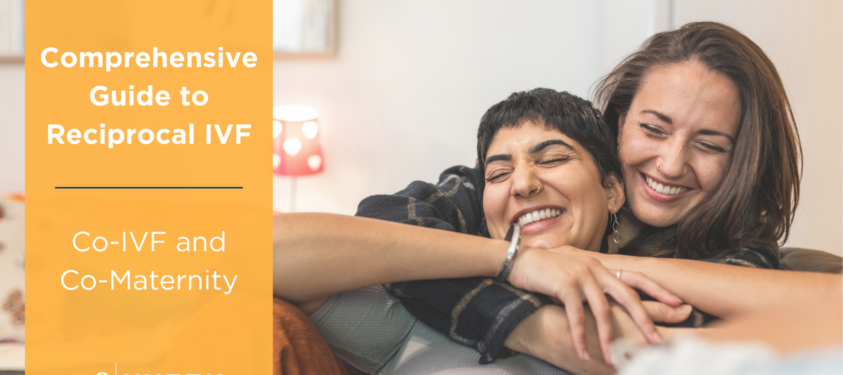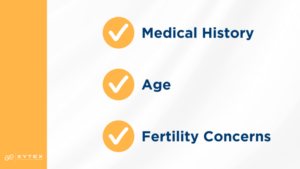Reciprocal IVF: How Co-IVF Helps LGBTQ Couples Share the Journey to Parenthood

How Co-IVF Helps LGBTQ Couples Share the Journey to Parenthood
Reciprocal IVF (Co-IVF) has helped thousands of LGBTQ+ couples turn their family-building dreams into a reality. Through this fertility treatment, lesbian and trans-men couples can embark on the journey to parenthood together, allowing one partner to provide the eggs while the other carries the pregnancy.
The result? A truly special bond between partners and their soon-to-be baby.
If you and your partner are new to co-maternity, then taking the first steps on this empowering IVF journey can be equally exciting and intimidating. From selecting a donor to welcoming your beautiful baby into the world, this comprehensive guide will walk you through:
- What is reciprocal IVF?
- What to expect during the process
- What you need to consider before starting
- Who benefits from co-IVF?
- The future of co-maternity
Let’s get started!
What is Reciprocal IVF?
Reciprocal IVF, also known as co-IVF or co-maternity, is an empowering process that allows same-sex couples assigned female at birth to share a biological connection during pregnancy. Simply put, one partner will provide the eggs, while the other is the gestational carrier.
But how exactly does it work?
One partner will supply the eggs, undergoing ovarian stimulation and egg retrieval to do so. Those eggs are then fertilized using their selected donor sperm.
Finally, the resulting embryos are transferred to the other partner’s uterus.
This journey is truly special, and allows both partners to share motherhood: one genetically, and the other by carrying the pregnancy, unlike with traditional IVF.
For many couples, choosing a sperm donor is a special moment during this unique pathway to parenthood as they work together to choose the best donor for their family.
At Xytex, we’ve helped tens of thousands of people grow their families. Through our rigorous sperm donor screening process, including lab testing and genetics testing, we strive to deliver top-quality specimens and always put your satisfaction journey first.
The Role of Medical & Reproductive Evaluations

Before you embark on this life-changing journey, you and your partner must decide who will supply the eggs and who will carry the pregnancy.
Other than personal preference, several factors may influence your decision, such as:
- Medical history
- Age
- Fertility concerns
Working closely with a fertility specialist can help you make the most informed decision possible. Your fertility specialist will consult medical evaluations, including:
- Reproductive evaluation: Both partners will have assessments to check their fertility health, especially the ovarian reserve, for which the partner will provide the eggs.
- Uterine evaluation: The partner who will carry the pregnancy will have exams to make sure their uterus is ready for pregnancy.
Additionally, you may want to consider psychological counseling or other support to navigate the emotional complexities and decisions associated with co-maternity.
How Reciprocal IVF Works Step by Step

While the co-IVF journey to parenthood is unique to every couple, here is a brief overview of what you and your partner can expect:
Step 1: Initial Consultation
- During your initial consult, you’ll meet with your fertility specialist to discuss your family goals and create a personalized treatment plan.
Step 2: Ovarian Stimulation
- After you and your partner have decided on who will provide the eggs and who will carry the pregnancy, the partner who has decided to provide their eggs will start hormone injections to encourage egg development.
- There will be regular check-ups to monitor follicle growth and hormone levels.
Step 3: Egg Retrieval
- Once the follicles are ready, the eggs are retrieved in a simple outpatient procedure.
Step 4: Fertilization with Donor Sperm
- The retrieved eggs are then fertilized using your selected donor sperm in a lab.
- The embryos will be monitored for several days to see how they develop.
Step 5: Embryo Transfer
- Next, a chosen embryo is transferred into the uterus of the partner who will carry the pregnancy.
- Additional follow-up blood tests will confirm if the implantation was successful.
Step 6: Pregnancy & Birth
- The carrying partner experiences the pregnancy, and both partners get to share every special moment until the baby arrives!
Now, let’s take a look at some additional decisions you may want to consider before starting IVF.
Legal and Parental Rights Considerations
Before beginning co-IVF, it’s important to understand the legal parentage for both partners.
Since family and reproductive law can vary depending on where you live, speaking with a lawyer is often the best course of action. A lawyer can help you protect your parental rights and navigate any legal issues:
- Legal documents
- Pre-birth orders
- Second-parent adoptions
- And other rights to protect both you and your partner
Additionally, legal protocols might be different if one or both partners are trans-men, depending on local regulations. We recommend speaking with a lawyer before beginning this process to protect your family.
Who Benefits from Reciprocal IVF?
Lesbian and trans-men couples (assigned female at birth) benefit from reciprocal IVF, with both partners often finding the process to be empowering.
Not only does co-IVF allow LGBTQ+ couples to share a biological connection during the pregnancy, but this journey to parenthood can create truly special emotional bonds between partners and baby, allowing same-sex couples to experience “co-maternity,” or shared motherhood.
While the success of IVF depends on a variety of factors, the process is most beneficial to couples when one partner has a quality egg supply and the other is physically ready to carry a pregnancy.
Future Possibilities: Will Two Women Ever Share 100% of the Genes?
As of now, it’s not scientifically possible for two females to have a baby with both genetic contributions.
However, there’s exciting stem cell research and gene editing breakthroughs on the horizon that could make this a reality in the future. It’s important to note that if proven successful, additional clinical trials, ethical considerations, and other protocols would need to be addressed, resulting in a lengthened timeline of making this medical breakthrough available to couples.
For now, co-IVF remains a great LGBTQ+ family planning option for partners who want to share the special experience of pregnancy.
At Xytex, we’re committed to keeping you updated on the latest fertility news. Stay tuned for updates about how your options may progress beyond reciprocal IVF.

FAQs
Still have questions? Check out these common Co-IVF questions and answers below.
Can two women have a biological child together?
- Reciprocal IVF is the closest option available right now.
How is Reciprocal IVF different from traditional IVF?
- In Reciprocal IVF, one partner provides the egg, and the other carries the pregnancy.
How much does Reciprocal IVF cost?
- It typically ranges from $15,000 to $30,000, depending on location and the fertility clinic.
What type of vials are required for Reciprocal IVF?
- Assisted Reproductive Technology (ART) vials are required for IVF. At Xytex, we provide ART vials prepared to meet the needs of IVF treatments.
What are the success rates for Reciprocal IVF?
- Success rates are generally between 40-60% per cycle, and can depend on a variety of factors like age and health. Note: At Xytex, sperm quality is our top priority. We are committed to providing you with donor sperm that is the industry’s most selective, most tested, and most successful. Learn more about our commitment.
Could science eventually allow two women to have a baby with both of their genes?
- Science has not yet advanced to this point, but it may become possible with future breakthroughs in stem cell research and gene editing.
Conclusion
For many, becoming a parent is one of life’s greatest joys.
With Reciprocal IVF, LGBTQ+ partners can share the special journey to parenthood. Through this empowering process, lesbian and trans-men couples will make decisions together and work closely with a fertility specialist to determine their pathway to pregnancy and parenthood.
While 100% gene sharing doesn’t yet exist, many couples who undergo co-IVF not only form a biological connection with their child, but also an emotional bond that stays with them long after they welcome their baby into the world.
For over 50 years, Xytex cryo-sperm bank has helped tens of thousands of people make their dreams of parenthood a reality. To learn more about IVF and how Xytex can help you build your family with the most selective and tested donor sperm, contact us today.


